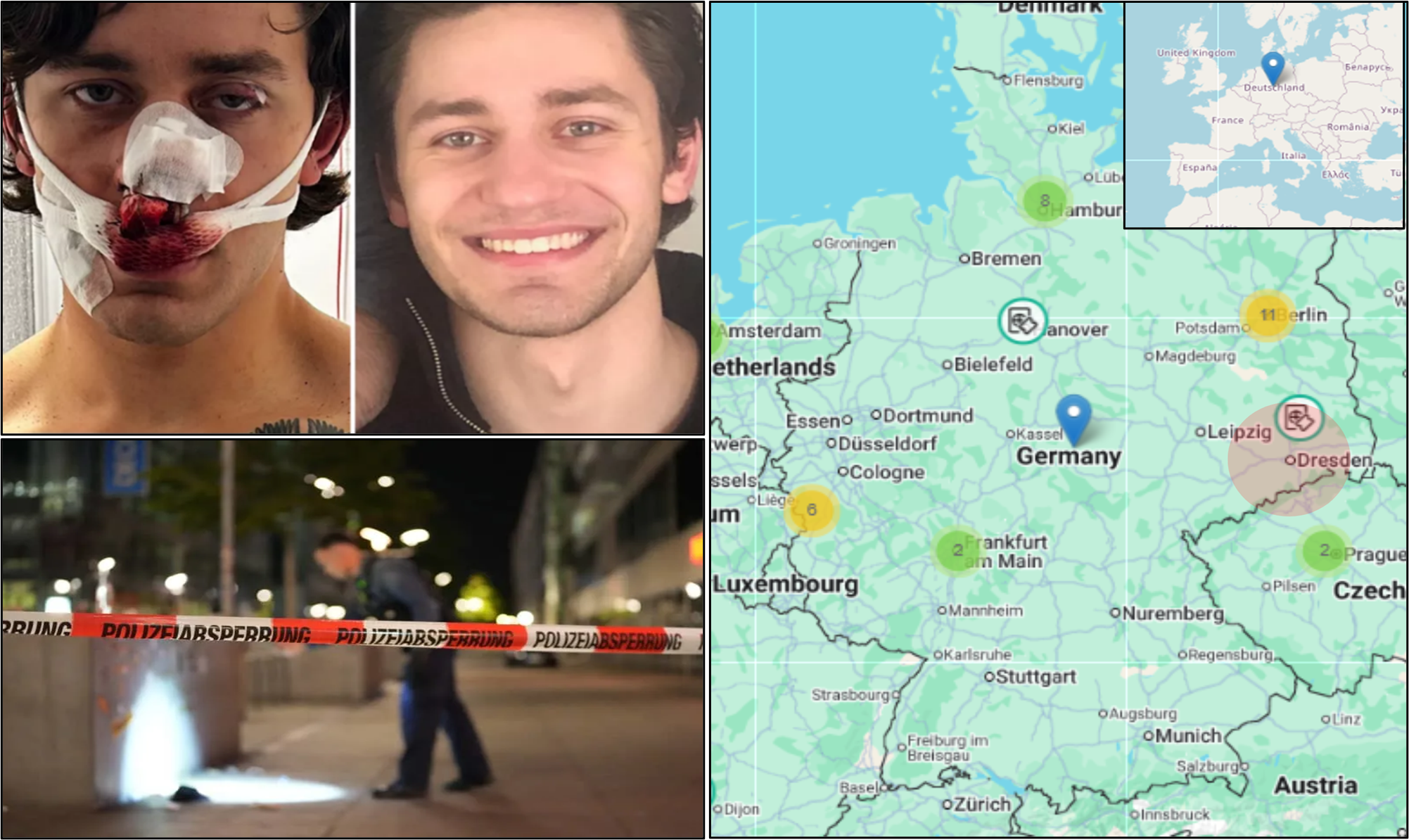| Reported: 24th August 2025 | Location: Dresden, Germany |
Security Event. On 24 August 2025, a 21-year-old American citizen was seriously injured in a knife attack on a late-night tram in Dresden (Germany). The victim sustained a deep facial wound requiring surgery. Authorities initially detained a 21-year-old Syrian man on the day of the incident but released him due to insufficient evidence; he was re-arrested on 26 August after new information emerged, while a second suspect, a 20-year-old Syrian man, turned himself in and was arrested on 29 August.
Fig 1- Victim, Dresden Tram Attack Site Imagery, and Fig 2 – Germany Security Incidents Map (Sourced by Neptune’s Travel Risk Management App)
Comment. In Germany, knife attacks have surged markedly, with official records showing an average of 79 such offences daily in 2025, totalling over 29,000 incidents in the previous year and a 17% increase in blade-related assaults during the first half of 2025 compared to 2024. This escalation contributes to broader violent crime trends, where dangerous and grievous bodily harm cases reached 158,177 in 2024, a 2.4% rise, with nearly 30% occurring in public streets, paths, and squares – locations often traversed by business travellers. Public transport hubs, such as railway stations in major cities like Hamburg and Nuremberg, emerge as hotspots, with over 214,000 violent crimes nationwide in 2023, including spikes in stabbings that have claimed innocent lives in transit settings.
Across Europe, homicide rates and assaults in major cities underscore risks to bystanders, with the EU recording 3,930 intentional homicides in 2023, a 1.5% increase, often in urban centres where business professionals congregate. Cities like Coventry (UK) lead with a crime index of 66, driven by high rates of violent assaults and thefts, while Tallinn (Estonia) and Marseille (France) follow at around 65 and 63 respectively, featuring elevated gang-related killings and assaults in tourist districts and transport hubs that could ensnare unsuspecting travellers. Complementing these threats, cities like London illustrate how opportunistic crimes can intersect with violence, as seen in the surge of watch and jewellery thefts – with 6,109 luxury watches stolen in 2022 alone, valued at over £162 million, and a 60% increase that year, though targeted police operations have reduced incidents by up to 50% in 2025. Nonetheless, jewellery related street-theft in affluent boroughs that business travellers frequent like Westminster, contributes to a global stolen watch value exceeding £1.3 billion in 2022. In these environments, innocent persons face heightened dangers, as evidenced by rising organised crime violence spilling into public spaces, with 10% of EU citizens reporting exposure to crime or violence in their neighbourhoods.
Worldwide, big cities exhibit stark disparities in homicide rates, with Pietermaritzburg in South Africa topping 82 per 100,000 residents in 2025, largely from syndicate-driven killings in urban centres, while Fortaleza in Brazil records 69 per 100,000 amid gang wars affecting metro areas frequented by international delegates. Caracas in Venezuela exceeds 100 per 100,000, with organised crime targeting business districts and public transport, leading to collateral deaths among innocent bystanders; even in safer hubs like New York, rates hover at 3.4 per 100,000, but localised spikes in public spaces persist. These patterns highlight how everyday locations – such as stations, streets, and commercial zones – can turn deadly for those caught in random or targeted acts of violence. Such trends emphasise the need for proactive measures to reduce the risk to travellers in global hubs.
Assessment. Incidents like the Dresden attack frequently stem from unpredictable lone wolf actors, whose actions – often driven by spontaneous impulses or ideological motives – can erupt suddenly in public spaces. This reality amplifies the critical need for organisations to uphold their corporate duty of care responsibilities, by proactively equipping travelling employees with the tools to identify and mitigate diverse risks in unfamiliar settings. Each company is bespoke to its own requirements. As a rule of thumb, companies that deploy their employees to unfamiliar or sometimes semi-permissive locations should consider a strategy complete with policies and plans, access to security intelligence, employee training, and, if appropriate the use of monitoring and SOS alert and emergency response apps. These tools help build practical knowledge through structured modules that address key areas like thorough destination research, secure in-country navigation, emergency first aid techniques, and identifying risk. Ultimately, such targeted preparation not only minimises personal vulnerabilities but also strengthens organisational resilience, ensuring seamless operations amid rising urban uncertainties worldwide.

